Occupational Environment Monitoring at the Consumer Goods Manufacturing Plant
99,000 ₫
Note: The above price is calculated for one sample, and the price may vary depending on the area of the environment to be monitored and market fluctuations. For more accurate pricing support, please refer to the quotation table or contact our consulting staff directly.
Occupational environment monitoring at a consumer goods manufacturing plant is a process of collecting, analyzing, and evaluating workplace factors that may harm workers’ health.
Table of Contents
Toggle1. Overview of consumer goods manufacturing plants
a. What is a consumer goods manufacturing plant?
Manufacturing plant for consumer goods is a production facility with the main goal of manufacturing products used in the daily lives of consumers. This is where items are produced that consumers use to meet personal, family, or daily work needs.
Consumer goods manufacturing plants often apply industrial production processes to mass-produce products with a high level of automation. The processes include machining, assembly, quality inspection, packaging, and transporting products to consumers or retail stores.
The main objective of consumer goods manufacturing plants is to produce high-quality, safe products that comply with quality and safety standards.

b. Production stages in consumer goods manufacturing plants
In consumer goods manufacturing plants, there are various production stages to create the final products. Below are some common stages in the consumer goods manufacturing process:
- Research and development: This stage involves researching, developing, and designing new products. Engineers and designers create technical drawings and product prototypes.
- Machining and fabrication: Materials and product components are processed and fabricated into separate parts. Processes may include cutting, welding, pressing, stamping, CNC machining, and coating.
- Assembly: Parts and components are assembled together. Workers assemble products according to defined procedures, using tools and machines to ensure accuracy and efficiency.
- Quality inspection: Products are inspected to ensure they meet standards and regulatory requirements. Inspections may include technical checks, functionality tests, safety checks, and durability tests.
- Packaging: After inspection, products are appropriately packaged for protection and transport. Packaging may include boxing, plastic wrapping, bagging, labeling, and sealing.
- Transportation: After packaging, products are transported to retail outlets or storage facilities to reach consumers.

c. Types of machinery used in consumer goods manufacturing plants
In consumer goods manufacturing plants, many types of machinery and equipment are used to perform production and processing stages. Below are some common types of machinery in consumer goods manufacturing plants:
- Cutting and processing machines: Including metal cutting machines, laser cutters, plastic cutters, wood cutters, heat presses, plastic presses, and CNC machines for cutting, welding, pressing, and machining various materials.
- Pressing and molding machines: Including plastic presses, high-frequency presses, tropical molding machines, and plastic injection machines to create components and product parts.
- Printing machines: Including offset printers, thermal printers, heat transfer printers, inkjet printers, UV printers, and 3D printers for printing labels, images, and product details.
- Packing and boxing machines: Including automatic packaging machines, bagging machines, boxing machines, stamping machines, and labeling machines to package and prepare products for shipment.
- Quality inspection machines: Including hardness testers, durability testers, thickness testers, accuracy testers, functionality testers, and safety testers to ensure product quality.
- Capping and sealing machines: Including capping machines, sealing machines, and heat sealers to ensure product integrity and safety.
- Freezing and cooling machines: Including refrigerators, ice makers, freezers, and ice cream machines to produce frozen and cooled products.
- Baking and heating machines: Including bread makers, noodle machines, bakery ovens, grills, and cake makers for baked and hot products.

d. What occupational diseases may occur among workers in consumer goods manufacturing plants?
Workers in consumer goods manufacturing plants may suffer from certain occupational diseases related to environmental and job factors. Below are some common occupational diseases that may occur:
- Respiratory diseases: Employees working in environments with dust, fumes, smoke, and chemicals may develop asthma, bronchitis, pneumonia, and rhinitis.
- Skin diseases: Long-term exposure to chemicals, oils, additives, and solvents may cause skin problems such as dermatitis, infections, itching, and rashes.
- Ear-related diseases: Loud noises from machinery and equipment in plants can cause hearing damage, including hearing loss, tinnitus, and other ear problems.
- Mental health issues: Stressful and high-pressure work environments in consumer goods production may lead to stress, anxiety, depression, and other psychological problems.
- Spinal and joint diseases: Working in incorrect postures or lifting heavy objects may lead to disc degeneration, joint degeneration, and other spine and joint problems.
- Hand and neck disorders: Using tools and machinery in production may cause injuries and conditions such as carpal tunnel syndrome, periarthritis, and numbness.
To protect workers’ health, safety measures, protective equipment, and workplace environment controls must be implemented, including using personal protective equipment, ensuring ventilation and exhaust fans, providing occupational safety training, and complying with relevant occupational health and safety regulations and standards.

e. Common types of consumer goods on the market
There are many common types of consumer goods on the market, below are some examples:
- Food and beverages: Including products such as processed foods, soft drinks, fruits, vegetables, meat, fish, milk, flour, sugar, spices, sauces, and confectionery.
- Electronics: Including devices such as mobile phones, computers, cameras, music players, game consoles, TVs, tablets, and other household electronics.
- Clothing and fashion accessories: Including clothes, shoes, bags, jewelry, watches, hats, and other fashion accessories.
- Household items: Including products such as furniture (tables, chairs, beds, wardrobes), kitchenware (pots, pans, dishes, cups, appliances), interior items (lamps, decorative lights), gardening tools, and other household products.
- Beauty and personal care products: Including cosmetics, perfumes, skincare, haircare, body care products, makeup, oral care products, and other beauty-related items.
- Everyday essentials: Including toothbrushes, soap, toilet paper, water bottles, office supplies, school supplies, and household items such as plastic bags, kettles, flashlights, and other daily-use products.
2. Overview of workplace environment monitoring services
a. What is workplace environment monitoring in consumer goods manufacturing plants?
Workplace environment monitoring (or workplace environment measurement) in consumer goods manufacturing plants is the activity of collecting, evaluating, and analyzing measurement indicators of workplace environmental factors in manufacturing plants, in order to apply timely solutions, minimize environmental impacts on workers’ health, and prevent occupational diseases. Workplace environment monitoring is mandatory for consumer goods manufacturing plants.
Workplace environment monitoring plays the most important role in protecting, caring for, and improving workers’ health, as the main resource of businesses and the direct source of profits is the workforce. Workers who are frequently exposed to occupational hazards exceeding permissible standards will suffer health effects and develop occupational diseases.
REGISTER FOR WORKPLACE ENVIRONMENT MONITORING SERVICE
b. Nam Viet’s workplace environment monitoring program
Nam Viet’s workplace environment monitoring program is a program developed by monitoring engineers in occupational safety and environmental protection. With the goal of ensuring workers’ health and safety, this program uses modern measurement methods to monitor air quality, water, microclimate factors, physical factors, dust, etc., in the workplace. This program is very important in ensuring a safe working environment and protecting workers’ health.
In addition, Nam Viet’s workplace environment monitoring program also plays an important role in researching and developing new solutions to improve workplace environmental quality. With the dedication and professionalism of its monitoring experts, Nam Viet’s exclusive monitoring program is becoming a breakthrough in occupational safety and environmental protection management in Vietnam.

c. Standardization in workplace environment measurement processes
Standardization in Nam Viet’s workplace environment measurement processes is a very important aspect in ensuring the quality of measurement results. To guarantee accuracy and reliability of results, this program applies recognized standards and standardized procedures from the Ho Chi Minh City Department of Health. This ensures that the collected data is highly reliable for workplace environment evaluation and for making decisions to improve workplace conditions and protect workers’ health.
These standardized procedures also ensure that results are conducted by a highly qualified monitoring team with years of experience, enabling managers and experts to rely on An Toan Nam Viet’s results and make precise, valuable decisions in protecting workers’ health and the environment.
By applying standardization in workplace environment measurement processes, Nam Viet demonstrates its commitment to ensuring a safe working environment and protecting workers’ health, while also contributing positively to improving occupational safety and environmental protection management in Vietnam.
d. Workplace environment monitoring reports for consumer goods manufacturing plants
Workplace environment monitoring results are prepared according to form No. 04 Appendix III issued with Decree 44/2016/ND-CP and prepared in 02 copies: 01 copy sent to the workplace contracting the monitoring service, and 01 copy archived at the monitoring organization.
The storage duration of workplace environment monitoring results, as regulated by law, is permanent archiving.

e. Frequency of workplace environment monitoring according to the law
According to Clause 2 of Article 18 of the Law on Occupational Safety and Hygiene 84/2015/QH13, employers must organize workplace environment monitoring to evaluate harmful factors at least once per year.
f. Deadline for submission of workplace environment monitoring reports according to the law
The deadline for report submission is before December 31 each year. Enterprises in manufacturing facilities are required to submit workplace environment monitoring reports to the local Department of Health where the business is headquartered and where employees are working.
When there are changes in technology processes, production processes, or when upgrading facilities that may generate new harmful factors affecting workers’ health, enterprises must update occupational hygiene records regarding harmful factors requiring workplace environment monitoring.
g. Penalties for violations of workplace environment monitoring obligations by employers
According to Article 27 of Decree No. 12/2022/ND-CP dated 17/01/2022 on administrative penalties in the field of labor, social insurance, and Vietnamese workers working abroad under contracts:
- Clause 2: A fine of VND 2,000,000 – 5,000,000 for employers who fail to publicly disclose to workers at the workplace the results of workplace environment monitoring and hazard assessments immediately after results are available.
- Clause 3: A fine of VND 20,000,000 – 40,000,000 for employers failing to conduct workplace environment monitoring to control occupational hazards as required by law.
- Clause 4: A fine of VND 40,000,000 – 60,000,000 for employers colluding with workplace environment monitoring organizations to commit fraud in monitoring activities, without reaching criminal prosecution level.
3. Harmful environmental factors for workers in consumer goods manufacturing plants
In consumer goods manufacturing plants, there are several harmful environmental factors that can affect the health and safety of workers. Below are some environmental factors that may cause harm:
- Chemicals: The use of chemicals in the production of consumer goods can be dangerous for workers. For example, toxic chemical compounds, toxic fumes, allergens, flammable substances, or carcinogens. Exposure to these substances can cause skin irritation, rhinitis, respiratory issues, and the risk of poisoning.
- Dust and small particles: During the production of consumer goods, dust and small particles can be generated from processes such as machining, cutting, grinding, and drying. Long-term exposure to dust and small particles can damage the respiratory system, cause pneumonia, or lead to other health issues.
- Noise: Machinery and production processes in consumer goods plants can generate loud noise. Continuous and excessive noise can cause hearing problems, stress, and affect the overall health of workers.
- Temperature and humidity: The working environment in consumer goods manufacturing plants may have fluctuations in temperature and humidity. Extremely high or low temperatures along with inappropriate humidity can cause heat stress and affect workers’ health and performance.
- Physical impacts: Environmental factors such as collisions, accident risks, and working in confined spaces can endanger workers. These factors can cause injuries, fractures, scratches, or other harm to workers.
REGISTER FOR OCCUPATIONAL ENVIRONMENTAL MONITORING SERVICE
4. Measures to improve the working environment in consumer goods manufacturing plants
To improve the working environment in consumer goods manufacturing plants, the following measures can be applied:
- Ensure occupational safety: Provide sufficient personal protective equipment (including helmets, safety glasses, gloves, protective clothing) to protect workers from risks and accidents during work.
- Chemical management: Ensure safe use and storage of chemicals. Provide proper chemical usage instructions, apply leakage control measures, and safely handle chemical waste.
- Adjust temperature and humidity: Ensure the working environment has comfortable temperature and humidity levels. Provide air conditioning, ventilation, and fans to maintain ideal environmental conditions.
- Adjust noise levels: Apply soundproofing measures, provide protective headphones, and use advanced technological equipment to reduce noise at the source.
- Provide occupational safety and health training: Train workers on safe working procedures, use of personal protective equipment, and occupational disease prevention measures.
- Control dust and small particles: Use dust extraction and air filtration systems to reduce dust and small particles during production. Provide protective masks to prevent respiratory risks.
- Manage physical impacts: Ensure spacious and safe working areas to avoid accidents and injuries. Apply regular inspection and maintenance measures for machinery and equipment.
- Promote awareness of health and safety: Create a working environment that enhances health and safety awareness, encouraging employees to participate in training courses and educational programs on occupational safety and health.
- Periodically organize occupational environmental monitoring in factories, collect and analyze harmful factors for workers, and then adjust and reduce the risks to prevent occupational diseases for them.
5. Benefits of periodic monitoring of consumer goods manufacturing plants
An Toan Nam Viet provides excellent benefits to businesses when using occupational environmental monitoring services according to the provisions of Decree 44/2016/ND – CP on the management and control of harmful factors in the working environment affecting workers.
- Businesses can proactively control harmful factors at workshops or factories.
- Receive consultation and recommendations on measures to minimize harmful factors and improve the quality of the working environment.
- Indirectly protect human resources, the main driving force in the development process of the business.
- Minimize the harmful effects of occupational diseases on human health, thereby reducing future medical treatment costs.
- Workers’ health is improved, leading to ensured and maintained product quality and productivity.
- Comply with occupational safety laws and avoid legal risks.
- Create reputation and professionalism in all aspects, thereby enhancing the brand value for businesses.
The environmental monitoring service of Nam Viet is the solution to minimize the harmful effects of occupational diseases, contributing to creating a healthy and quality working environment.

6. National occupational environmental monitoring center
Occupational environmental monitoring center of Nam Viet is a professional unit in monitoring and measuring the quality of the working environment throughout all provinces and cities in Vietnam. With a team of experienced monitoring specialists, the center uses modern measuring equipment to ensure accuracy and reliability.
In addition to providing monitoring services, the center also supports customers in planning, handling, and tracking occupational environmental issues. With the motto “customers are the center”, the center focuses on customer satisfaction, meeting all customer needs, and committing to providing the best solutions for businesses.
REGISTER FOR OCCUPATIONAL ENVIRONMENTAL MONITORING SERVICE
With investments in technology, equipment, and human resources, the monitoring center of Nam Viet has been and is becoming one of the prestigious units in the field of occupational environmental monitoring in Ho Chi Minh City with the following goals:
- We always value our brand reputation and the quality of our products and services.
- We provide customers with the best possible and most suitable solutions.
- Together with a team of experienced Masters and Engineers with expertise, with the desire to protect the environment and bring benefits to businesses.
- With the Occupational Environmental Monitoring team of Nam Viet, your company will receive professional service from experts in the monitoring field, along with the best cost advantages.
The process of conducting occupational environmental monitoring at Nam Viet includes the following basic steps:
- Before conducting occupational environmental monitoring, our company always ensures that machinery and equipment serving occupational environmental monitoring are adjusted and calibrated in accordance with the law.
- Implement the occupational environmental monitoring process correctly and fully as committed with the Department of Health.
- Honestly report the results of occupational environmental monitoring to the employer.
- In case the results of occupational environmental monitoring do not ensure safety for workers, Nam Viet company will support in providing remedial solutions and the workplace will implement as follows:
- Implement measures to improve working conditions to minimize the effects of harmful factors and prevent occupational diseases.
- Organize health examinations to detect early occupational diseases and work-related illnesses for workers in unsafe working environments.
- Provide physical allowances to workers according to labor law regulations.

7. Occupational environmental monitoring quotation
To help businesses carry out occupational environmental monitoring in a professional and effective manner, Nam Viet provides customers with a price quotation table for occupational environmental monitoring services with quality and reasonable cost.
- Our monitoring quotation table provides detailed information about the prices of the monitoring services we are providing. It also includes costs related to transportation, measurement, analysis, and result reporting. Customers can be completely assured of the accuracy and reliability of the monitoring reports we provide.
- We are committed to always offering the most competitive and reasonable prices in the market, and at the same time we are always ready to provide consultation and answer all questions about monitoring services quickly and professionally.
- With the monitoring quotation table of Nam Viet, customers can easily choose service packages suitable to their needs. We are committed to bringing the highest satisfaction to customers with professional service quality.
No comments yet

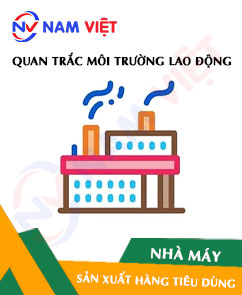
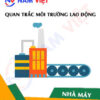
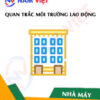



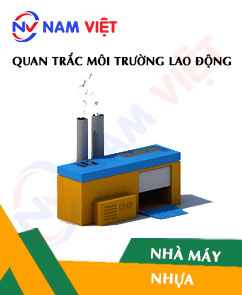


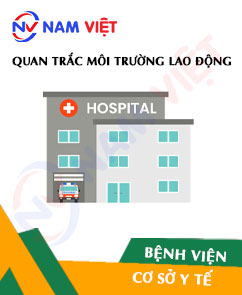

Review Occupational Environment Monitoring at the Consumer Goods Manufacturing Plant
There are no reviews yet.